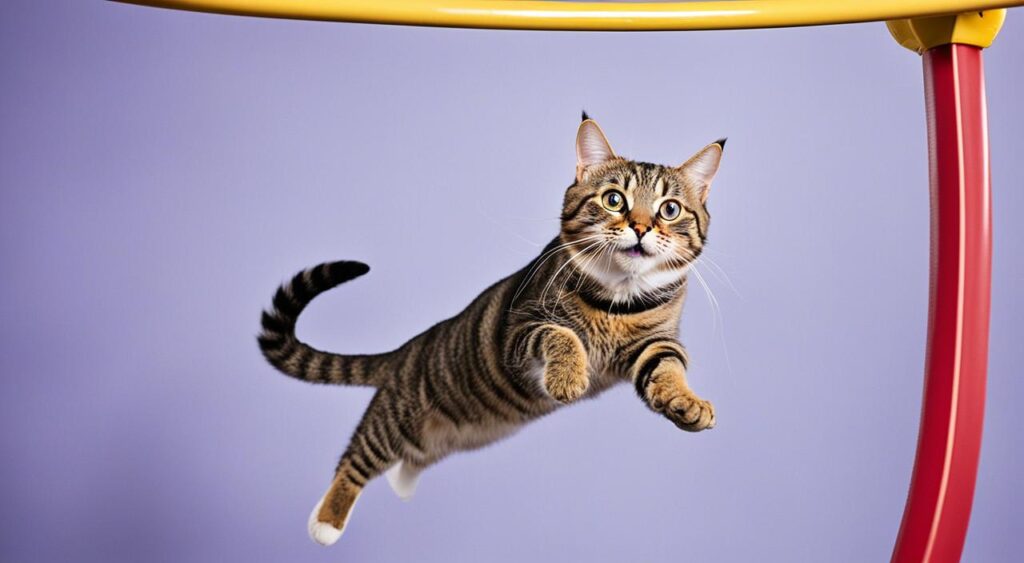Teaching your cat tricks can be a fun and rewarding experience for you and your furry friend. Not only does it provide mental stimulation and strengthen your bond, but it can also impress your friends and family with your cat’s newfound skills. In this section, we’ll explore effective techniques and methods to teach tricks to your cat, whether you’re a seasoned pet owner or just starting out. By following our step-by-step guide, you’ll be amazed at how quickly your cat can learn new tricks.
Key Takeaways:
- Teaching tricks to your cat can provide mental stimulation and strengthen your bond.
- Positive reinforcement is key to successful cat training.
- Understanding your cat’s personality can help tailor your training approach.
- Games and rewards can make training sessions more enjoyable for you and your cat.
- Consistency and patience are essential for successful cat training.
Why should you teach your cat tricks?
If you’re considering treinamento de gatos and ensinando seu gato a fazer truques, you’re on the right track towards strengthening your bond with your feline friend and enhancing their overall well-being. Teaching tricks to your cat can provide numerous benefits, including:
- Mental stimulation: Just like humans, cats need mental exercise to thrive. Learning new tricks can challenge your cat’s cognitive abilities and keep them mentally alert and engaged.
- Building a stronger bond: Training sessions provide a great opportunity to spend quality time with your cat and deepen your relationship. Consistent training can also foster a stronger sense of trust and communication between you and your pet.
- Providing entertainment: Cats are curious and playful creatures. Teaching them new tricks can provide them with endless entertainment and stimulate their natural desire to explore and learn.
Furthermore, engaging in treinamento de gatos can also be extremely rewarding for pet owners. Watching your cat develop new skills and behaviors can be a source of pride and satisfaction, while also providing a fun and unique way to interact with your furry companion.
Overall, teaching your cat tricks is a win-win for both you and your pet. The next section will focus on getting started with training and providing tips for success!
Getting Started with Training Your Cat
If you are new to cat training, we have everything you need to get started. The first step is to understand the basics of cat training, which includes the use of positive reinforcement and an understanding of your cat’s individual personality.
Using positive reinforcement means rewarding your cat for good behavior. This can be done with treats, praise, or anything else your cat finds rewarding. Punishment should never be used as a training tool as it can harm the bond between you and your cat.
Understanding your cat’s personality is also key to successful training. Some cats are more independent and may require different training techniques than others. Observe your cat’s behavior and personality traits to determine what motivates them and what training methods work best.
Here are some practical tips and tricks to set the stage for successful training sessions:
- Start with short but frequent training sessions to keep your cat engaged and prevent boredom.
- Choose a quiet and distraction-free environment for training.
- Set achievable goals and gradually increase the difficulty level of commands.
- Be patient and remain consistent with your training routine.
Remember, the key to successful cat training is patience, consistency, and positive reinforcement. With time and effort, you’ll be amazed at what your furry friend can learn.
| Positive Reinforcement | Punishment |
|---|---|
| Rewards good behavior | Instills fear and anxiety |
| Builds trust and strengthens bond | Harms bond and creates aggression |
| Motivates learning and engagement | Creates avoidance and apathy |
Choosing the Right Rewards for Training
When it comes to training your cat, finding the right reward can make all the difference. Positive reinforcement is key, and the right incentive can motivate your cat to learn and perform new tricks. Here are a few things to consider when choosing rewards:
What motivates your cat?
Some cats are food-driven, while others prefer toys and playtime as rewards. Consider your cat’s preferences when selecting a reward. If your cat is food-driven, try using small, soft treats that are easy to chew and digest. If your cat prefers playtime, use their favorite toy as a reward.
Keep it consistent
Consistency is key when training your cat. It’s important to use the same reward consistently throughout the training process to provide a clear incentive for your cat to keep learning. Inconsistencies in rewards can confuse your cat and undermine their progress.
Make it special
To make the reward feel special, reserve it only for training sessions. This will help your cat associate the reward with good behavior and learning, and make it more meaningful than if it were given to them on a regular basis.
Avoid overfeeding
While treats can be an effective reward for your cat, it’s important to avoid overfeeding. Use small, low-calorie treats to ensure your cat stays healthy and doesn’t gain weight. You can also adjust their regular meals to account for the additional calories from training treats.
Tips for Choosing Effective Rewards
| Reward Type | Pros | Cons |
|---|---|---|
| Food treats | Effective for food-driven cats, easy to dispense, and can be tailored to your cat’s dietary needs. | Can cause weight gain if overused and can be messy. |
| Playtime | Gives your cat exercise and mental stimulation, and can promote bonding. | Not as effective for food-driven cats and may require more time and effort on your part. |
| Praise/affection | Cost effective, can be used anywhere, and doesn’t require any special tools or treats. | May not be effective for all cats, especially those that are not highly motivated by praise or attention. |
Teaching Basic Commands to Your Cat
Teaching basic commands to your cat is an essential part of your pet’s training. Not only does it make for a well-behaved kitty, but it also strengthens your bond and builds trust between you and your feline friend. Follow our passo a passo guide to teach your cat fundamental skills such as sit, stay, and come.
Step 1: Start with Sit
Command your cat to sit while holding a treat above its head. As your cat raises its head, it will sit down naturally. Reward your cat with the treat and repeat this exercise approximately five to ten times a day until your cat responds quickly to the “sit” command.
Step 2: Teach Stay
Once your cat masters the “sit” command, you can move on to “stay.” Ask your cat to sit, and then take a step back. If your cat stays seated, reward it with a treat. Gradually increase the distance as your cat improves its skill. Be sure to use the verbal cue “stay” every time you step back.
Step 3: Train for Come
The “come” command is an essential part of cat training. Put your cat in a sit position and step back, then call your cat by its name followed by the command “come.” Once your cat comes to you, reward it with a treat. Keep practicing until your cat responds consistently to the “come” command.
| Training Tip: | Use treats as rewards, but make sure they’re small and healthy. Too many treats can cause your feline friend to gain weight. |
|---|
With patience and consistency, your cat will learn these basic commands and have fun doing it. Remember to keep training sessions short and to take breaks, as overworking your cat can lead to frustration. Keep practicing these skills and watch as your cat becomes a well-trained, obedient companion.
Advanced Tricks for Your Cat
Now that your cat has learned the basics, it’s time to challenge them with more advanced tricks and behaviors. Not only will this showcase their intelligence and agility, but it will also provide a fun and rewarding experience for both you and your feline friend.
One advanced trick you can teach your cat is to jump through a hoop. You will need a hula hoop and treats to entice your cat. Hold the hoop low to the ground and encourage your cat to jump through it using a verbal cue or by holding out a treat. Gradually raise the hoop as your cat becomes proficient.
Another advanced trick is the high-five. Start by holding a treat in your hand and getting your cat’s attention. Raise your hand slightly, so your cat lifts their paw to reach for the treat, then say the command “High-five” or “Give me five”. Repeat this process until your cat can perform the trick without the treat.
| Trick | Description |
|---|---|
| Roll over | Ask your cat to lie down, then lure them onto their back with a treat. Slowly move the treat in a circle, encouraging your cat to roll over. Use the verbal command “Roll over” and plenty of praise. |
| Play dead | Teach your cat to lie down on their side, then use a verbal command such as “Bang” to signal them to play dead. Reward them with a treat and plenty of petting to reinforce the behavior. |
| Fetch | Encourage your cat to chase and retrieve a toy, rewarding them with a treat each time they bring it back to you. Use positive reinforcement to encourage them to repeat the behavior. |
Remember to always use positive reinforcement and keep training sessions short and fun. With patience and persistence, your cat can learn even the most impressive tricks.
Problem-solving during training
Even with the most diligent training, problems can arise during the process of teaching your cat tricks. Stay calm and keep these tips in mind to overcome any hurdles:
Distractions
Cats are known for their curious nature, which can often lead to distractions during training sessions. If your cat is distracted, try moving to a quieter location or using toys and treats to get their attention back on track.
Stubbornness
Some cats may be more resistant to training than others. If your cat seems stubborn, try breaking down the trick into smaller steps and rewarding them for each accomplishment. Patience and persistence are key!
Mistakes
It’s important to remember that making mistakes is part of the learning process. Don’t get discouraged if your cat doesn’t get a trick right away. Instead, focus on positive reinforcement and praise for even small progress.
“Cats are like potato chips; it’s hard to have just one.” – Image of a cat playing with a toy –
With these tips in mind, you can overcome any challenge that may arise during your cat’s training. Keep practicing and don’t forget to have fun along the way!
Tailoring Training to Your Cat’s Personality
Just like humans, cats have unique personality traits that affect their learning style. When it comes to ensinar comandos para gatos and providing treinamento de gatos, it’s crucial to adapt your training techniques to best suit your cat’s individual needs. Consider the following tips when tailoring your approach:
Identify Your Cat’s Learning Style
Some cats learn best through visual cues, while others respond more to auditory signals. Additionally, some cats may prefer to learn through physical cues or even taste rewards. Observe your cat’s behavior and body language during training sessions to determine which methods work best for them.
Adjust Your Training Approach
Once you understand your cat’s learning style, adjust your training approach to best suit their needs. For example, if your cat responds well to visual cues, incorporate hand signals into your training routine. Alternatively, if your cat prefers taste rewards, try using a favorite treat to motivate them during training sessions.
| Learning Style | Best Training Techniques |
|---|---|
| Visual | Hand signals, use of toys |
| Auditory | Verbal cues, clicker training |
| Physical | Touch cues, interactive play |
| Taste | Treat rewards, food puzzles |
Be Patient and Flexible
Remember that every cat is unique, and it may take some trial and error to find the best training techniques for your feline friend. Be patient, and don’t give up if a particular method doesn’t work. Keep adjusting your approach until you find what works best for your cat’s personality and learning style.

Fun and Interactive Games for Training
Training your cat doesn’t have to be all serious work. Engaging your furry friend in fun and interactive games can make the process more enjoyable and effective. Here are a few ideas to keep your cat engaged and enthusiastic about learning new tricks.
Hide and seek
Hide treats throughout your home and encourage your cat to seek them out. As your cat becomes more adept at the game, increase the difficulty by hiding treats in harder-to-find locations.
Agility courses
Set up an obstacle course using everyday items such as boxes and chairs. Encourage your cat to navigate the course and reward them with treats for successful completion.
Fetch
Teach your cat to retrieve and return toys or objects to you. Use positive reinforcement techniques such as treats and praise to encourage your cat to engage in this playful game.
Puzzle toys
Provide your cat with puzzle toys that require problem-solving skills to access treats or toys. This can stimulate your cat’s mental abilities and increase their confidence.
Follow the laser pointer
Many cats love to chase laser pointers. Use this to your advantage by directing the pointer to guide your cat through a series of tricks and commands, such as sit, stay, and come.
Incorporating these fun and interactive games into your cat’s training routine can make the process more enjoyable and effective for both you and your furry friend. Experiment with different games to find what works best for your cat, and watch their skills and confidence grow.
Overcoming Training Plateaus
As with any type of training, it’s common for cats to hit plateaus or become disinterested after a certain point. But don’t worry – there are techniques you can use to keep your cat motivated and engaged in their training.
One effective technique to overcome training plateaus is to break up your training sessions into smaller, more manageable sessions throughout the day. This will not only prevent your cat from becoming bored, but it will also help reinforce their learning and retention of new tricks.
Another technique to try is to introduce new challenges and variations into your training routine. For example, if your cat has mastered the “sit” command, try adding in a new element such as “sit and stay” or “sit and spin.”
It’s also important to keep your cat’s reward system fresh and varied. Experiment with different types of treats and toys to find what motivates your cat the most.
And don’t forget the power of positive reinforcement and praise. Consistently rewarding your cat’s successes and progress will help keep them motivated and engaged in their training.
Consistency and Patience in Cat Training
Training your cat takes time, effort, and above all, patience. It’s important to keep in mind that every cat is different and may require a unique training approach. Consistency is key when it comes to training your furry companion. By establishing a consistent training schedule and using positive reinforcement each time your cat correctly completes a trick or command, you’ll help them associate training sessions with positive experiences.
Don’t rush the training process. Remember that learning takes time, and your cat may require multiple training sessions before fully grasping a particular trick or skill. Celebrate small wins along the way, as this will help build your cat’s confidence and encourage them to keep trying.
It’s essential to remain calm and patient during training sessions. If you become frustrated or upset, your cat may pick up on this negative energy and become discouraged. Stay relaxed and make training sessions a positive and enjoyable experience for both you and your cat.
Remember, training your cat is a journey, not a destination. Be patient, stay committed, and enjoy the process as you watch your feline friend learn and grow.

Conclusion
Teaching tricks to your cat can provide numerous benefits for both you and your furry companion. With the right approach, you can provide mental stimulation, strengthen your bond, and enjoy hours of entertainment with your cat.
By following our step-by-step guide and utilizing positive reinforcement, you can teach your cat essential commands and even advanced tricks. Remember to tailor your training approach to your cat’s unique personality and learning style, and don’t be afraid to get creative with interactive games and new challenges.
Consistency and patience are key when it comes to cat training, so establish a regular training schedule and maintain a positive attitude throughout the process. With dedication and commitment, you can unlock your cat’s hidden talents and forge a deeper connection with your furry friend.
Start training your cat today and see what amazing things they can achieve!
FAQ
How do I teach tricks to my cat?
Teaching tricks to your cat can be a fun and rewarding experience. Start by using positive reinforcement techniques, such as treats or clicker training, to encourage your cat to perform desired behaviors. Break down the trick into smaller, achievable steps and gradually increase the difficulty as your cat progresses. Remember to be patient and consistent in your training efforts.
Why should I teach my cat tricks?
Teaching tricks to your cat offers several benefits. It provides mental stimulation and helps prevent boredom, which is especially important for indoor cats. It also strengthens the bond between you and your feline companion. Additionally, learning tricks can help your cat become more obedient and responsive to commands, which can be useful in various situations.
What rewards should I use for training my cat?
When training your cat, it’s important to choose rewards that motivate them. Treats, such as small pieces of cooked chicken or commercial cat treats, are often effective. You can also use praise and petting as rewards, as many cats respond positively to physical affection. Experiment with different rewards to see what works best for your cat.
How do I teach basic commands to my cat?
To teach basic commands to your cat, start by using a single-word cue, such as “sit” or “come”. Use positive reinforcement, rewarding your cat with treats or praise when they perform the desired behavior. Break down the command into small steps and be consistent with your cues. With patience and repetition, your cat will learn to associate the command with the behavior you want.
What should I do if my cat is not learning the tricks?
If your cat is struggling to learn tricks, it’s important not to get discouraged. Cats have different learning styles and some may require more time and patience than others. Evaluate your training techniques and consider if there are any distractions or challenges that may be hindering your cat’s progress. Break down the trick into smaller steps and adjust your approach if necessary. Seeking guidance from a professional cat trainer may also be helpful.




